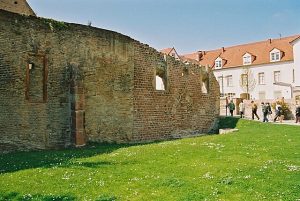Creating a Physical Setting

Remnants of the medieval synagogue in Speyer, Germany. By James Steakley – Own work, CC BY-SA 3.0, https://commons.wikimedia.org/w/index.php?curid=8625608
enticing and hostile, the Jews of medieval Europe required the support of fellow Jews, organized physically in supportive neighborhood enclaves, politically in effective negotiating associations, and spiritually in supportive networks.
Jews banded together throughout medieval Europe in neighborhood enclaves that provided a sense of security and solidarity. Early on, these neighborhoods were entirely voluntary; with the passage of time they became compulsory, demanded by the Church and enforced by the lay authorities. Beyond security and solidarity, the Jewish enclaves provided all the physical necessities of Jewish life—synagogues, schools, ritual baths, food facilities, and cemeteries. While most of the physical remains of Jewish community life in medieval Europe have disappeared, enough remains to afford a rich sense of these indispensable facilities.
Images
- Speyer medieval synagogue- view from the northwest, view from the northeast, sandstone tile floor
- Synagogue of Santa Maria la Blanca, Toledo, 13 th century
- Córdoba Synagogue, south and north walls, 1314-15
- Detail of the Dedicatory Inscription of the Synagogue of El Tránsito, Toledo, 1357
- Illuminating the Synagogue, Sister Haggadah, ca. 1350
- Speyer ritual bath
- Women ritually cleaning dishes in the mikvah, Moorish Haggadah, ca. 1300, Castile
Primary Texts
Secondary Literature
- Y. Assis, The Golden Age of Aragonese Jewry- Community and Society in the Crown of Aragon, 1213-1327 (London- The Littman Library of Jewish Civilization, 1997), 199-234.
- S. Codreanu-Windauer, “Regensburg- The Archeology of the Medieval Jewish Quarter,” in The Jews of Europe in the Middle Ages (Tenth through Fifteenth Centuries), 391-404.
- P. Manix, “Oxford- Mapping the Medieval Jewry,” in The Jews of Europe in the Middle Ages (Tenth through Fifteenth Centuries), 405-420.
- M. Porsche, “Speyer- The Medieval Synagogue,” in The Jews of Europe in the Middle Ages (Tenth through Fifteenth Centuries), 435-448.
- K. Muller, “Wurzburg- The World’s Largest find from a Medieval Jewish Synagogue,” The Jews of Europe in the Middle Ages (Tenth through Fifteenth Centuries), 379-390.
Videos
What do you want to know?
Ask our AI widget and get answers from this website